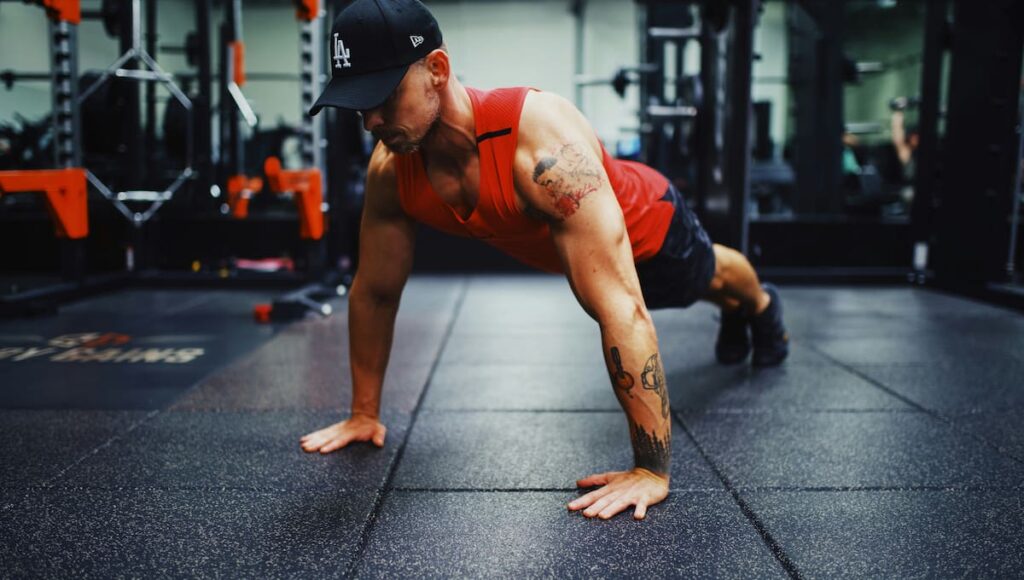Bodyweight exercises like push-ups, squats, and crunches are staples of fitness routines. They’re simple, require no equipment, and can be done almost anywhere. But what happens if you do these exercises every day for a month? This article explores the physiological changes, benefits, and potential downsides to performing these three exercises daily.
Overview of Push-Ups, Squats, and Crunches
Before diving into the effects of doing these exercises every day, it’s important to understand what muscles they target and their benefits.
- Push-Ups: Primarily work the chest (pectorals), shoulders (deltoids), triceps, and engage the core for stability.
- Squats: Target the quadriceps, hamstrings, glutes, and also engage the core for balance.
- Crunches: Focus on the rectus abdominis (the “six-pack” muscle) and the obliques, engaging the core.
Now, let’s look at what happens to your body when you incorporate these exercises into your daily routine for a month.
Week 1: Initial Adaptation

Muscle Engagement and Activation
The first week of performing push-ups, squats, and crunches daily will engage the muscles in new ways, particularly if you’ve been inactive or inconsistent in training. You’ll likely experience Delayed Onset Muscle Soreness (DOMS), especially if you’re not accustomed to regular exercise.
Physiological Response:
- Neuromuscular Adaptation: Your body begins to improve neuromuscular efficiency, which means your muscles will start working together more efficiently. This improves coordination and helps you perform exercises with better form.
- Initial Strength Gains: Early strength gains are usually neurological rather than purely muscular. Your body becomes more adept at recruiting muscle fibres to handle the new workload.
Recovery Needs: You might feel tight or sore, especially in the areas worked by these exercises. Proper recovery (hydration, nutrition, and sleep) is vital during this period.
Metabolic Changes
Even in the first week, you might notice an increase in your metabolism. Push-ups, squats, and crunches activate large muscle groups, increasing your body’s energy expenditure. This could lead to slight weight loss or body fat reduction, especially if paired with a calorie-controlled diet.
Week 2: Strength and Muscle Tone

Increased Muscle Definition
By week two, you should start seeing some visible muscle definition, especially if you’ve maintained a consistent daily routine. Push-ups will start to define your chest, shoulders, and arms, squats will tone your thighs and glutes, and crunches will sculpt your core.
Muscle Growth: During this time, you might not see a significant increase in muscle size (known as hypertrophy), but your muscles will become firmer and more defined.
Endurance Improvement: Your muscles will begin to handle more repetitions with less fatigue, increasing your muscular endurance.
Improvement in Posture and Core Stability
One of the main benefits of daily bodyweight exercises is improved posture. Push-ups, squats, and crunches all engage the core muscles, which are essential for maintaining good posture.
Core Strength: The core stabilises the body during all these exercises, which translates into better posture, reduced back pain, and improved balance.
The Only 8 Bodyweight Exercises You Need to Build Muscle Fast
Week 3: Enhanced Cardiovascular Health and Stamina

Cardiovascular Conditioning
By week three, you will likely notice improvements in your cardiovascular health. Though these exercises are typically seen as strength-building movements, performing them daily and with high repetitions provides a cardiovascular boost by keeping your heart rate elevated.
Heart Health: Exercises like squats and push-ups, especially when done in rapid succession or in circuits, can contribute to better cardiovascular conditioning. Your resting heart rate may lower, and you might experience increased stamina during other physical activities.
Improved Circulation: Regular exercise improves blood circulation, helping deliver more oxygen to your muscles, which in turn aids recovery and performance. Improved circulation can also lead to clearer skin, reduced fatigue, and better overall energy levels.
Caloric Burn and Fat Loss
The cumulative caloric burn of performing these exercises daily becomes more apparent. You might experience modest fat loss as your body becomes more efficient at burning calories even at rest (thanks to increased muscle mass and metabolic rate).
Fat Loss: Fat loss will be most noticeable in areas like the abdomen, where crunches specifically target and burn belly fat when combined with proper nutrition. Squats and push-ups, being compound movements, will contribute to fat loss from larger muscle groups.
Week 4: Plateau and Potential Overtraining

40 Hard Workouts at Home to Build Better Conditioning and Transform your Body
The Plateau Effect
After three weeks of continuous daily exercise, your body may begin to plateau. A plateau occurs when your muscles adapt fully to the routine, and progress stalls. While your body becomes more efficient at the exercises, the rate of improvement may slow down.
Strength Maintenance: While you may not see dramatic strength gains in the fourth week, you will continue to maintain the strength and endurance developed over the previous weeks.
Muscle Adaptation: Muscles adapt to the workload, and without increasing resistance or changing the exercise routine, hypertrophy might stagnate. This plateau is common in exercise regimens without progression or variation.
Risk of Overtraining
At this point, it’s crucial to assess whether daily exercise is sustainable without risking overtraining. Overtraining can lead to muscle fatigue, joint pain, and even injury.
Signs of Overtraining:
- Persistent muscle soreness and fatigue
- Reduced performance or strength
- Irritability or mood changes
- Trouble sleeping or feeling overly fatigued during the day
It’s important to listen to your body. Rest and recovery are vital components of any fitness routine, even for bodyweight exercises.
The End of the Month: Final Results and Takeaways
Strength Gains
After a month of doing push-ups, squats, and crunches daily, you will have likely seen significant strength gains, particularly in the upper body (from push-ups), lower body (from squats), and core (from crunches).
Upper Body: More defined and stronger chest, triceps, and shoulders. Lower Body: Toned and stronger quadriceps, hamstrings, and glutes. Core: Improved core strength, potentially leading to more visible abdominal muscles if body fat percentage has decreased.
Fitness Challenge – Try 200 Mike Tyson Push-Ups in 10 Minutes
Muscle Endurance
Muscle endurance is one of the most noticeable improvements. You will be able to perform more repetitions of each exercise with less fatigue, indicating a higher level of muscular endurance and stamina.
Fat Loss and Lean Muscle Gain
 Source: Szabolcs Toth / Unsplash
Source: Szabolcs Toth / UnsplashWhile the degree of fat loss will vary depending on diet and other factors, daily bodyweight exercises can contribute to a leaner physique. Body fat percentage may decrease slightly, and you will likely see improved muscle tone and definition.
Mental Health Benefits
In addition to the physical benefits, regular exercise offers numerous mental health benefits:
- Stress Relief: Daily exercise can significantly reduce stress and improve mood due to the release of endorphins.
- Improved Cognitive Function: Exercise has been linked to better memory, concentration, and overall cognitive function.
- Better Sleep: Regular physical activity can improve sleep quality, which in turn enhances recovery and overall well-being.
Potential Downsides and Considerations
Risk of Imbalances
Focusing exclusively on push-ups, squats, and crunches may lead to muscular imbalances. These exercises, while effective, don’t fully engage all muscle groups. For instance:
- Push-ups target the chest but neglect the pulling muscles (e.g. back muscles).
- Squats target the lower body but may not adequately strengthen the calves or stabiliser muscles around the hips and ankles.
- Crunches primarily work the rectus abdominis but can neglect deeper core muscles like the transverse abdominis and lower back.
To counterbalance this, incorporating pulling exercises (e.g. pull-ups) and exercises targeting stabiliser muscles is recommended.
Risk of Overuse Injuries

Repeatedly performing the same movements every day can increase the risk of overuse injuries. Common issues include:
- Shoulder pain from push-ups due to overloading the deltoids.
- Knee discomfort from squats if performed with improper form or inadequate rest.
- Lower back pain from crunches, especially if the exercise is done incorrectly.
Listening to your body and ensuring proper form can help mitigate these risks. It might also be wise to introduce rest days or cross-train with other exercises to allow full muscle recovery.
Sustainability
Daily exercise is mentally and physically taxing. While it’s possible to stick with this routine for a month, long-term adherence to daily push-ups, squats, and crunches without variation might lead to boredom, fatigue, or burnout. It’s essential to consider exercise variation, progressive overload (increasing reps, sets, or intensity), and rest to keep the body challenged and prevent burnout.
Conclusion
After a month of daily push-ups, squats, and crunches, you will notice improvements in muscle tone, strength, endurance, and possibly some fat loss. You may also benefit from enhanced cardiovascular health, better posture, and mental health gains. However, you may face a plateau or even overtraining without proper recovery or variation in your workout routine. The key to continuing progress is to challenge your body by either increasing the intensity of these exercises or incorporating different movements into your routine.
Key Takeaways
| Aspect | Change |
|---|---|
| Strength Gains | Significant increase in upper body, lower body, and core strength. |
| Muscle Definition | Visible muscle tone and improved firmness in key areas. |
| Endurance | Increased muscular endurance; easier to perform more reps. |
| Cardiovascular Health | Improved heart health and stamina, especially with high reps. |
| Posture and Core Stability | Better posture due to increased core strength and stability. |
| Fat Loss | Modest fat loss if paired with a healthy diet; improved muscle tone. |
| Risk of Overtraining | Potential for fatigue, soreness, and injury without proper rest. |
| Plateau | Strength gains may stagnate after initial improvement without progression. |
| Mental Health Benefits | Improved mood, stress relief, and better sleep patterns. |
| Sustainability | Need for exercise variation to avoid burnout and muscle imbalances. |
References
- McCall, P., 2018. How Muscles Adapt to Strength Training. ACE Fitness
- Schoenfeld, B.J., 2010. The mechanisms of muscle hypertrophy and their application to resistance training. Journal of Strength and Conditioning Research, 24(10), pp.2857-2872.
- Moore, D.R., 2014. Muscle damage and repair. British Journal of Sports Medicine, 48(13), pp.949-951.
- Haff, G.G. and Triplett, N.T., 2015. Essentials of Strength Training and Conditioning. 4th ed. Champaign, IL: Human Kinetics.
The Truth About Vibrating Belts for Exercise: Benefits, Myths, and Practical Tips


